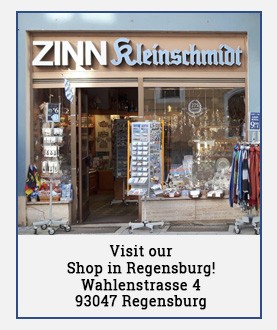If you would like to learn more about pewter manufacturing, follow the arrows through the stages of production in our workshop and even peer over Horst Kleinschmidt’s shoulder.

Today Malaysia and Indonesia are the main producers of raw tin where open surface mining is used. Bolivia also produces tin, although underground mining is used.
Tin ore is refined in the producing countries. It is poured into bars and arrives at our workshop with virtually 100% purity. A basic element symbolized by Sn, tin is a light-colored, relatively light metal. Its exact weight is 7.3, and its melting point lies at 232° centigrade.
Alone, pure tin is too soft and brittle for manufacturing purposes. It must be alloyed with copper and antimony. These additives make up about 5% of pewter and give the material more strength and better casting qualities.

Molds are warmed with liquid metal (lead). Steel molds may contain engraved motifs.

The tin is heated to 350° centigrade and poured into the mold with a ladle. The mold is simultaneously cooled with wet towels. This process guarantees a homogeneous crystal structure.

Opening the mold and removing the raw cast. The previously cast visual motif is clearly recognizable.

After the mold is opened, the unfinished castings must be cleaned and processed further.

The surfaces of rounded pieces such as pitchers, vases, candlesticks, etc. are smoothed out with a lathe. Pieces that cannot be rotated are smoothed with sanding and polishing.

All parts of a pitcher or mug, including the body, handle, lid, and hinge are cast separately and attached using a precision flame.

In order to make pewter reliefs more vivid, darkening may be used.

Depending on the design, the surface may be given an artistic patina or high-gloss polishing. However the natural, matt silver finish remains most popular.
Hand production and craftsmanship remain the best methods for making pewter pieces.







